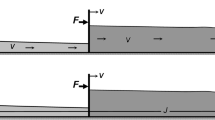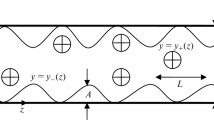The largest Lyapunov exponent characterizes the degree of exponential divergence of close trajectories of a dynamical system. The presence of a positive Lyapunov exponent in the system reveals rapid divergence of any two arbitrarily close trajectories with time and sensitivity to the values of the initial conditions. Therefore, as a result of determination of the Lyapunov exponent, it becomes possible to identify the system in a sense of chaotic dynamics. We propose a method for increasing the accuracy of the Benettin numerical algorithm aimed at the evaluation of the largest Lyapunov exponent in the case of a dissipative dynamical system. The results of calculations are presented for the hydrodynamic model of cross-shaped waves in a rectangular channel of finite size.
Similar content being viewed by others
References
P. Bergé, Y. Pomeau, and C. Vidal, Order Within Chaos: Towards a Deterministic Approach to Turbulence, J. Wiley & Sons, New York (1984).
V. A. Golovko, “Neural network methods for processing chaotic processes”, in: Scientific Session of MIFI-2005, VII All-Russian Scientific and Technical Conference “Neuroinformatics–2005”: Lectures in Neuroinformatics, Yu. V. Tyumentsev (ed.), MIFI, Moscow (2005), pp. 43–91.
T. S. Krasnopol’skaya and A. Y. Shvets, “Properties of chaotic fluid oscillations in cylindrical basins,” Prikl. Mekh., 28, No. 6, 52–61 (1992; English translation: Int. Appl. Mech., 28, No. 6, 386–394 (1992); https://doi.org/10.1007/BF00847097.
T. S. Krasnopol’skaya and A. Y. Shvets, “Chaotic oscillations of a spherical pendulum as an example of interaction with an energy source”, Prikl. Mekh., 28, No. 10, 61–68 (1992); English translation: Int. Appl. Mech., 28, No. 10, 669–674 (1992); https://doi.org/10.1007/BF00846923.
S. P. Kuznetsov, Dynamical Chaos, Fizmatlit, Moscow (2001).
F. Moon, Chaotic Vibrations: An Introduction for Applied Scientists and Engineers”, J. Wiley & Sons, New York, etc. (1987).
V. I. Oseledets, “A multiplicative ergodic theorem. Lyapunov characteristic numbers for dynamical systems”, Tr.. Mosk. Mat. Obshch., 19, 179–210 (1968); English translation: Trans. Moscow Math. Soc., 19, 197–231 (1968).
A. Yu. Shvets and V. A. Sirenko, “Scenarios of transitions to hyperchaos in nonideal oscillating systems”, Nelin. Kolyv., 21, No. 2, 284–292 (2018); English translation: J. Math. Sci., 243, No. 2, 338–346 (2019); https://doi.org/10.1007/s10958-019-04543-z.
G. Benettin, L. Galgani, A. Giorgilli, and J. M. Strelcyn, “Lyapunov characteristic exponents for smooth dynamical systems and for Hamiltonian systems; a method for computing all of them. Part 1: Theory”, Meccanica, 15, No. 1, 9–20 (1980); https://doi.org/10.1007/BF02128236.
G. Benettin, L. Galgani, and J. M. Strelcyn, “Kolmogorov entropy and numerical experiments”, Phys. Rev. A, 14, No. 6, 2338–2342 (1976); https://doi.org/10.1103/PhysRevA.14.2338.
J. P. Crutchfield, J. D. Farmer, N. H. Packard, and R. S. Shaw, “Chaos”, Sci. Am., 255, No. 6, 46–57 (1986); https://doi.org/10.1038/scientificamerican1286-46.
T. S. Krasnopolskaya, “Acoustic chaos caused by the Sommerfeld effect”, J. Fluid Struct., 8, No. 7, 803–815 (1994); https://doi.org/10.1016/S0889-9746(94)90300-X.
T. S. Krasnopolskaya, “Chaos in acoustic subspace raised by the Sommerfeld–Kononenko effect”, Meccanica, 41, No. 3, 299–310 (2006); https://doi.org/10.1007/s11012-005-5899-z.
T. S. Krasnopolskaya and G. J. F. Heijst, “Wave pattern formation in a fluid annulus with a radially vibrating inner cylinder”, J. Fluid Mech., 328, 229–252 (1996); https://doi.org/10.1017/S0022112096008701.
T. S. Krasnopolskaya, V. V. Meleshko, G. W. M. Peters, and H. E. H. Meijer, “Mixing in Stokes flow in an annular wedge cavity”, Eur. J. Mech. B-Fluids, 18, No. 5, 793–822 (1999); https://doi.org/10.1016/S0997-7546(99)00119-3.
T. S. Krasnopolskaya and E. D. Pechuk, “Peculiarities of parametric resonances in cross-waves”, Chaotic Modeling and Simulations, No. 3, 377–385 (2016).
J. Laskar, C. Froeschlé, and A. Celletti, “The measure of chaos by the numerical analysis of the fundamental frequencies. Application to the standard map**”, Physica D: Nonlinear Phenomena, 56, Nos. 2-3, 253–269 (1992); https://doi.org/10.1016/0167-2789(92)90028-L.
V. Meleshko, T. Krasnopolskaya, G. W. M. Peters, and H. E. H. Meijer, “Coherent structures and scales of Lagrangian turbulence”, Advances in Turbulence. VI. Fluid Mechanics and Its Applications, S. Gavrilakis, L. Machiels, and P. A. Monkewitz (eds.), Vol. 36., Springer, Dordrecht (1996), pp. 601–604; https://doi.org/10.1007/978-94-009-0297-8_171.
A. Y. Shvets and T. S. Krasnopolskaya, “Hyperchaos in piezoceramic systems with limited power supply”, IUTAM Symposium on Hamiltonian Dynamics, Vortex Structures, Turbulence, A. V. Borisov, V. V. Kozlov, I. S. Mamaev, and M. A. Sokolovskiy (eds.), IUTAM Bookseries, Vol. 6, Springer, Dordrecht (2008), pp. 313–322; https://doi.org/10.1007/978-1-4020-6744-0_27.
A. Shvets and S. Donetskyi, “Transition to deterministic chaos in some electroelastic systems”, 11th Chaotic Modeling and Simulation International Conference. CHAOS 2018, C. H. Skiadas and I. Lubashevsky (eds), Springer Proceedings in Complexity, Springer, Cham (2019), pp. 257–264; https://doi.org/10.1007/978-3-030-15297-0_23.
F. Takens, “Detecting strange attractors in turbulence”, D. Rand and L. S. Young (eds)., Dynamical Systems and Turbulence, Lecture Notes in Mathematics., Vol. 898, Springer, Berlin–Heidelberg (1981), pp. 366–381; https://doi.org/10.1007/BFb0091924.
A. Wolf, J. B. Swift, H. L. Swinney, and J. A. Vastano, “Determining Lyapunov exponents from a time series”, Physica D: Nonlinear Phenomena, 16, No. 3, 285–317(1985); https://doi.org/10.1016/0167-2789(85)90011-9.
Author information
Authors and Affiliations
Corresponding author
Additional information
Translated from Matematychni Metody ta Fizyko-Mekhanichni Polya, Vol. 65, No. 1-2, pp. 209–215, January–June, 2022.
Rights and permissions
Springer Nature or its licensor (e.g. a society or other partner) holds exclusive rights to this article under a publishing agreement with the author(s) or other rightsholder(s); author self-archiving of the accepted manuscript version of this article is solely governed by the terms of such publishing agreement and applicable law.
About this article
Cite this article
Pechuk, V.D., Krasnopolska, T.S. Estimation of the Largest Lyapunov Exponent for a Model of Cross-Shaped Waves in a Rectangular Channel of Finite Size. J Math Sci 282, 862–869 (2024). https://doi.org/10.1007/s10958-024-07221-x
Received:
Published:
Issue Date:
DOI: https://doi.org/10.1007/s10958-024-07221-x




